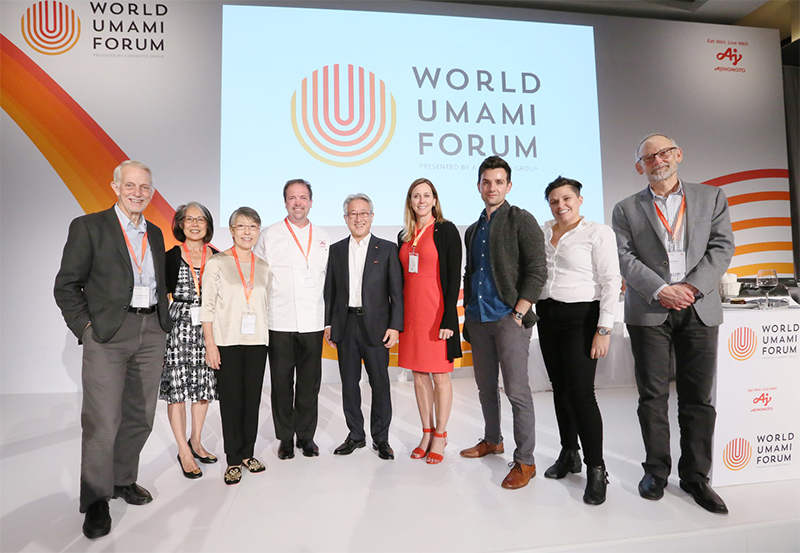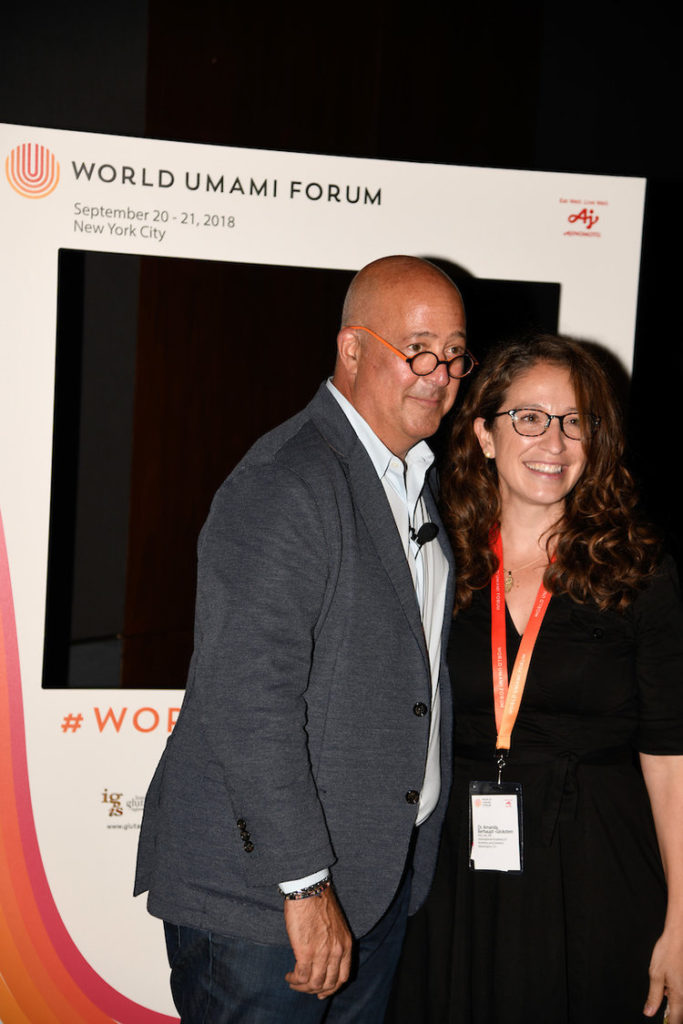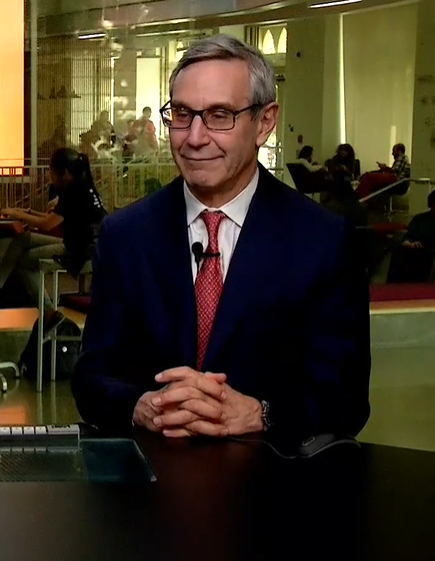How our perceptions of what’s safe to eat are swayed by the PR industry
Guest blog by Linda Bonvie
For two days in September 2018, the Conrad Hotel in New York City hosted an invitation-only shindig where large quantities of wine flowed, lunch and dinner were served, chefs whipped up dishes in cooking presentations and experts gave talks and demonstrations — all extensively photographed and videotaped.
Leading the event was the Travel Channel’s “Bizarre Foods” celeb chef, Andrew Zimmern, who posed with guests for untold numbers of photos wearing his trademark round spectacles perched low on his nose.
If you took a casual look at the goings-on, it might appear to have been any other well-planned, fancy corporate convention. But it wasn’t. This was more of a boot camp for journalists and bloggers to help them effectively spread the messaging of Ajinomoto, the world’s largest producer of monosodium glutamate.
Dubbed the “World Umami Forum,” the affair took place at the mid-point in a ten-million dollar campaign spearheaded by PR giant Edelman Public Relations. Among the goals of Edelman’s client Ajinomoto is to have the press (and eventually, they hope, everyone else) start replacing the tainted name of MSG with the more pleasing umami.

From left, Gary Beauchamp, PhD, Mary Lee Chin, MS, RD, Dr. Kumiko Ninomiya, Executive Fellow Ajinomoto, Chef Chris Koetke, Takaaki Nishii, CEO and President Ajinomoto, Tia M. Rains, public relations director Ajinomoto, Ali Bouzari, Sarah Lohman, Harold McGee.
Public relations blitzes, of course, are nothing new. There were plenty of tricky PR tactics spun for the benefit of Big Tobacco. Edelman, in fact, was behind such a campaign, as detailed in the tobacco industry cache of papers uncovered during decades of litigation. Its 1978 document called “Taking the initiative on the smoking issue – a total program,” designed for RJ Reynolds, outlines several ways that “another point of view on the cigarette question” could be promoted. One plan was the creation of a “National Smokers’ News Bureau” in New York, which would “set up interviews, organize editorial briefings…and engage in extensive personal contact with media to develop specific storylines.”
What makes a modern-day Edelman storyline travel much further than those in the past, however, is reflected by the sheer number of outlets to which they’re deployed, along with a media that seems more ready, willing and able to cooperate than ever before.
Dishing out disinformation over dinner and drinks

The articles and blogs that were published as a result of the umami gathering all had an amazingly similar ring to them. Authors always seemed to drop in a mention of “Chinese restaurant syndrome,” referring to a letter sent to the New England Journal of Medicine back in 1968 as the main reason why MSG got a bad rap in the U.S. (one of Edelman/Ajinomoto’s most oft repeated, fabricated storylines).
Some of the pieces were done more creatively than others, but all managed to drive home specific key points emphasized at the umami event, dutifully repeated by writers of all stripes. But no doubt it was the headlines that made the Edelman folks smug with the satisfaction of a job well done – most especially the one that ran in the Wall Street Journal.
The story, by WSJ writer River Davis, originally appeared in the April 27, 2019 print edition of the paper under the headline “Rescuing MSG’s Unsavory Reputation” — one quickly changed online to read, “The FDA Says It’s Safe, So Feel Free to Say ‘Yes’ to MSG.”
Even the subhead was altered, adding the word “healthy” in for good measure.
Realize for a moment that here we have a top-tier newspaper switching a headline and subhead so it contains a positive string of word parings (safe, healthy, MSG, yes), and ending with a long-used PR/marketing tactic known as a call to action. That’s when the consumer is instructed to do something that will help sales, e.g., “ask your doctor,” “click here,” “call now,” or in this case, “say yes.”
Why would the WSJ do that? I attempted to find out.
Asking the question in an email to Colleen Schwartz, a communications executive at Dow Jones, I continued to poke around online, soon finding a string of shared MSG stories at the Linkedin page of Edelman SVP of Food & Beverage Gennifer Horowitz.
She had posted several of the articles published after the umami forum, most to rave reviews from colleagues. But what caught my eye was the WSJ one with the “yes” headline, commented on by a Linkedin connection of Horowitz (who previously worked with the Andrew Zimmern “brand”): “What a huge win for Ajinomoto and MSG! Congrats to the whole team!”
Hmm, what could this huge win be? Might the comment be referring to the headline swap?
I took that question directly to Schwartz, asking if the change was made at the behest of Edelman Public Relations. Schwartz emailed back almost immediately, saying she would have a response for me the next day. When the next day rolled around, she said that she needed more time, as she was “coordinating with colleagues in APAC.”
The statement she finally came back to me with was simply: “Wall Street Journal articles regularly run with different headlines in print and digital due to independent editorial preferences and space constraints. In this case, the difference in headlines is noted in the tag online: ‘Appeared in the April 27, 2019, print edition as ‘Rescuing MSG’s Unsavory Reputation.’”
Asking further questions of Schwartz proved useless. “Our statement stands – I won’t have any further comment for you,” she wrote back.
Too close for comfort
For the casual reader to know the difference between true news reporting or a writer simply giving coverage to a PR firm’s storyline isn’t easy. In the case of Edelman, its connection to the WSJ is a long and established one, even where its employees are concerned.
For example, it’s no secret that Edelman NYC brand director Nancy Jeffrey spent 10 years as a WSJ writer. Nor is Edelman’s warm and fuzzy relationship with the paper hush-hush.
As quoted in an Edelman website blog, Jeffrey recalls how Richard Edelman (son of founder Dan) would call her during her time at the paper “to meet with a client with a story to tell.” The “Edelman ethos,” Jeffrey says, is that “no one at Edelman ever rises too high to pitch a reporter.”
As for headlines, getting your messaging above the actual story may even outperform whatever the article says.
In a New Yorker story titled How headlines change the way we think, writer Maria Konnikova tells about an Australian study that found a reader’s take-away from an article is, in fact, dictated by the headline.
“By its choice of phrasing,” she writes, “a headline can influence your mindset as you read so that you later recall details that coincide with what you were expecting.”
Utilizing that concept in the digital media age can warp your mindset even more. An article that appeared in the online publication Vox a few months after the umami affair, although headlined “But what does umami taste like?” contained a snippet of code in the page so that when it’s shared online, the headline is replaced with “MSG is the purest form of umami…,” a line also used in an Ajinomoto MSG “fact sheet” and by the Glutamate Association.
Owned media, or a media owned?

Mainstream media, said Edelman president and CEO Richard Edelman during an interview recently at the USC Annenberg School for Communication and Journalism, is on its way out. He calls the “notion” that media will continue on as we know them today “fallacious.” And what will replace them? According to Edelman, that will be “owned media,” meaning outlets – whether they be websites, blogs or even Facebook or Twitter accounts – over which businesses have complete control of content.
As newsrooms shrink, he says, companies are realizing “they have to tell their own stories.”
But considering how firms such as Edelman can enable companies that can afford a big PR tab to tell their own story anyway, will that really make much of a difference?
If Edelman has a catchphrase, it would probably be the Edelman Master Narrative, a.k.a. “the most important story you have to tell.”
Of course, when your client is Ajinomoto, that “story” will never include mention of the fact that MSG – a totally manufactured additive – is “excitotoxic,” meaning it can cause brain damage. It won’t disclose how MSG can trigger lifelong adverse reactions in an unborn child when a pregnant woman consumes food that contains the additive. Or that MSG, which always comes along with impurities in the finished product, is not identical to the glutamate in the human body and does not occur naturally in unprocessed foods. You won’t hear that MSG can cause a long list of adverse events (at levels that vary considerably from person to person), which can affect organs from the brain, to the heart, to the lungs to the bowels.
Do the folks at Edelman know this? Perhaps.
As reported in Gawker a decade ago, an unnamed PR executive “tipster” told how at an Edelman upper-management training session, attendees were told: “Sometimes you just have to stand up there and lie. Make the audience or the reporter believe that everything is OK.”
This is an excerpt from “A Consumer’s Guide to Toxic Food Additives: How to Avoid Synthetic Sweeteners, Artificial Colors, MSG, and More,” by Linda and Bill Bonvie, to be released March, 2020, Skyhorse Publishing.


